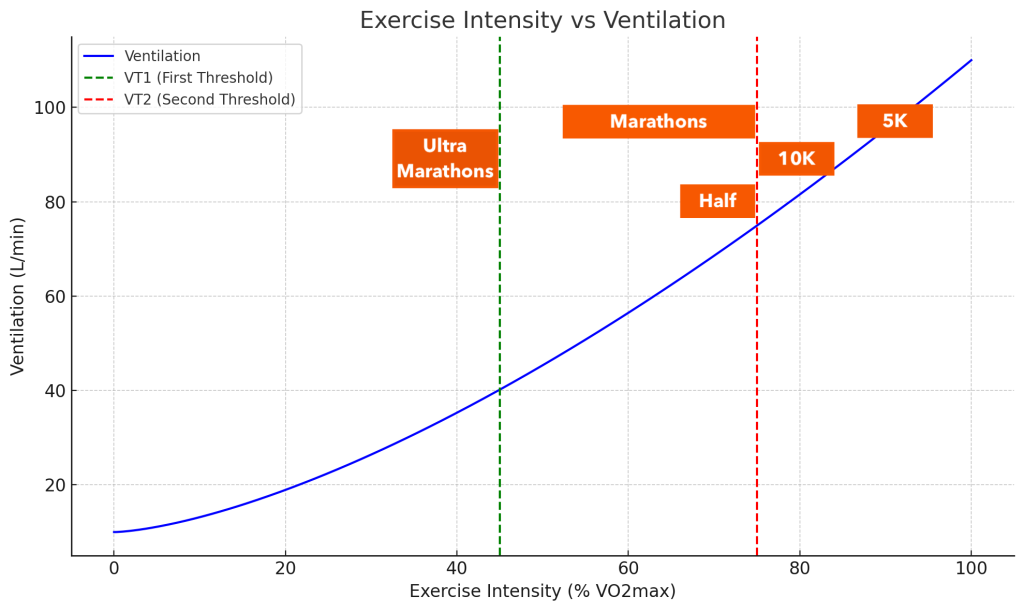Success in endurance sports isn’t just about grit—it’s about precision. One of the most overlooked performance strategies is aligning your race pacing with your ventilatory thresholds. Whether you’re targeting a 10K or a 100-miler, understanding how each race maps to your body’s internal limits is critical. That’s exactly where CHASKi steps in.
CHASKi is the first wearable designed specifically for endurance athletes to continuously monitor respiratory rate and identify ventilatory thresholds—giving coaches and athletes a powerful new tool to train smarter and race stronger.
Every Race Has a Zone—and It’s Not Always Where You Think
Each race distance sits in a unique intensity domain relative to an athlete’s physiological thresholds, this varies based on the level of training, being higher for higher level athletes:
- Ultras (50–100 mi) typically take place just below the first ventilatory threshold (VT1)—an effort that’s highly aerobic and sustainable for hours.
- Marathons and half marathons are performed between ventilatory thresholds, where lactate starts to accumulate but can still be managed. More trained athletes sit closer to VT2 pace than their counterparts.
- 10Ks and shorter events push above VT2, requiring high-intensity efforts supported by strong buffering capacity and anaerobic contribution.

These relationships are well established in the research. For example, ventilatory thresholds (VT1 and VT2) have been shown to correspond closely with metabolic markers like lactate threshold and critical power, making them a reliable proxy for performance planning (Lucía et al., 2000; Meyer et al., 2005).
Why Respiratory Rate is the Secret Weapon
Most wearables track heart rate or pace—but respiratory rate offers a more sensitive, earlier signal of physiological stress. Because respiratory rate rises sharply at VT1 and again at VT2, CHASKi can non-invasively detect when an athlete crosses these thresholds.
This unlocks huge potential for coaches:
- Personalize training zones based on real ventilatory responses—not estimations.
- Detect early signs of overreaching when respiratory rate drifts too high at a given workload.
- Adjust race pacing strategies in real time to stay within the optimal zone for the given distance.
Train the Right System for the Right Race
CHASKi helps align training sessions with the correct intensity zone for the race ahead:
- VT1-focused training for ultra-endurance events: long aerobic intervals, steady-state efforts.
- VT2-targeted sessions for marathons and half marathons: tempo runs, progressive pace workouts.
- Above-VT2 workouts for shorter races: high-intensity intervals, VO₂ max intervals, and anaerobic capacity development.
With continuous threshold tracking, CHASKi lets you adjust in real time—so training zones aren’t based on last quarter’s data, but on today’s physiology.
From Data to Execution: Real-Time Decision Making
When race day comes, CHASKi’s real-time respiratory rate monitoring helps athletes:
- Stay below VT2 in the early stages of a marathon.
- Avoid premature fatigue in ultras by sticking to VT1 effort.
- Dial in top-end efforts without crossing red lines too early.
No more guessing. No more generic pacing. Just precision based on your own respiratory data, minute by minute.
Final Thought: Train With What Your Body Tells You
Understanding how ventilatory thresholds align with different race intensities changes the game. With CHASKi, athletes and coaches don’t have to estimate—they can measure. And with that data, they can design race strategies and training plans that are grounded in real physiology, not outdated formulas.
Whether you’re coaching elites or pushing your own limits, CHASKi makes the invisible visible—helping you train exactly at the edge of performance.
Sources:
[1] Lucía A, et al. Physiology of professional road cycling. Sports Med. 2001;31(5):325–337.
[2] Meyer T, et al. Determination of ventilatory thresholds. Int J Sports Med. 2005;26(1):28–37.
[3] Foster C, et al. Pattern of respiratory frequency during exercise. J Appl Physiol. 1986;60(6):2013–2020.
[4] Beltrami FG, et al. Relationship between ventilatory thresholds and lactate thresholds in elite cyclists. Int J Sports Med. 2012;33(12):1036–1041.

